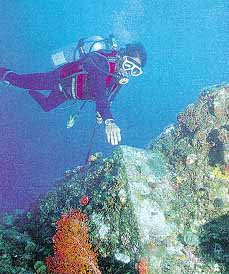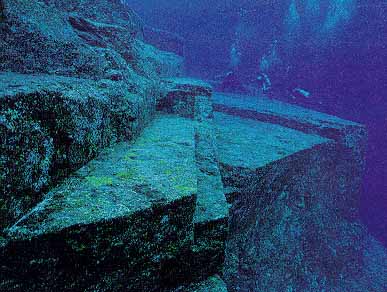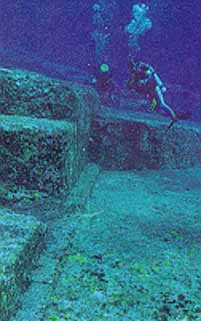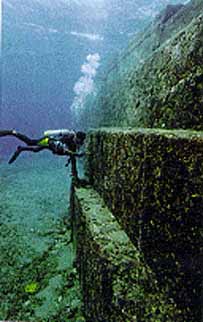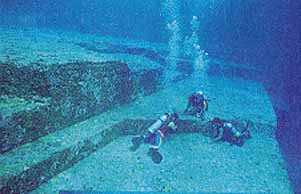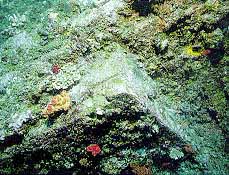Quando esta notícia se espalhou, houve um debate no grupo sci.archaeology da USENET. Concluiu-se, infelizmente, que não há indícios de que as formações, apesar de parecerem artificiais, realmente sejam artificiais. Abaixo segue um trecho da discussão, retirado do Doug's archaeology site (
http://www.ramtops.demon.co.uk/ ):
========================
A Geological Look at the Japanese 'Underwater Pyramids'
[This is from a discussion on Usenet and is posted here by permission of the
author].
[NOTE: The original links to the Team Atlantis site no longer work. I'm not
sure Team Atlantis has done, but the Image Gallery is no longer accessible
from their site. Archae has kindly found some new links where possible. Doug
Weller, Sept 12 1999] Re: Jap. underwater pyramids
Author: Archae Solenhofen
Date: 1998/10/29
Forum: sci.archaeology
Regards,
Archae Solenhofen (
solenhofen@usa.net)
On Tue, 27 Oct 1998 09:43:14 +0000, "host" wrote:
>In article <
36351a61.12284360@news.baynet.net>,
solenhofen@usa.net (Archae
Solenhofen) wrote:
>>Boy, your are just chalked full of irrelevant speculation now aren't you.
>Well you haven't given me anything to alter my perception of the site.
>>I thought the meaning in my above statment was rather clear nd straight
forward, but yet you
>>seem to be rather confused about it. Do you care to address the statement
or just conjecture
>>about my interests or how objectively I can look at a photograph.
>But it seems thats exactly what you want me to do.
Yes, that is right. I want you to tell us what is so unnatural about the
structures in the photographs at the
http://teamatlantis.com/ site.
>As i said i am not a geologist nor do i pretend to be one, I openly admit
my naivety on the subject
>therefore i do not want to get into a 'heated' discussion on subject matter
that i am not familiar with.
Well that hasn't stopped you from replying in a geologic context to my posts
and to others in the past, so why would it bother you now?
> On the other hand you are a distinguished expert in your field, so you
say,
Never said that.
>that is why i am asking you to explain the 'geological abnormalities', or
at least help explaining the
>natural causes of such a site.
So let me get this straight... I originally ask one person to give examples
of photos that exhibit unnatural formations at the Yonaguni Jima site . You
then jump in and say all those at teamatlantis.com website are examples of
this. I then ask _you_ to tell us what is unnatural about them. Now you are
telling me it is my responsibility to explain all 'geological
abnormalities'.... is that right? Ya, talk about "throwing it back". Look
you are the one who introduced the teamatlantis.com photos as examples of
unnatural formations; it is your responsibly to tell us what is unnatural
about these photos... so far you have failed to do that but instead fall
back on the "I am not a geologist" excuse (which is irrelevant since you
don't think they are natural).
>I think all you have said on the subject is that its called jointing. Not
alot in that for me really.
Well the discussion on columnar jointing was in response to your claim that
the Giant's Causeway had "no similarities whatsoever" in common with the
Yonaguni Jima outcrops. Your argument was essentially based on your
explanation of the processes involved in the formation of the Giant's
Causeway morphology, which was overly simplistic and very lacking reflecting
your poor knowledge of geology. As for jointing, this should be of great
interest to you since the blocky angular morphology of the Yonaguni Jima
site is the main argument for artificiality.
>>> anyway,
>>>
http://teamatlantis.com/ states the composition of the rock formations as
>>>two kinds of sandstone and basalt.
>>Where does it say that on their site? Do they tell us if they are
interbedded sandstone
>>and basaltic flows or a sandstone unit intruded by a diabase sill?
>Look, for the last time i am not a geologist,
I cannot find the information that you claim is at the
http://teamatlantis..com/
site regarding the "composition" of the rocks. So can you give me a source
for this claim of "two kinds of sandstone and basalt"? The point was that
the
http://teamatlantis.com/ site supplies little to no geologic information
about the outcrops. This is rather surprising for a scientific exploration
of an underwater site since it is actually quite easy to do (all it involves
is taking down a hammer and chipping and bagging a few samples). In fact out
of all the photos at the teamatlantis.com website only one has a rock
lithology in its caption (and in most no scale or location is given although
many have a diver in the photo and this helps). This is an example of the
extremely poor science exhibited at the teamatlantis.com website.
>all you are doing is confusing the original question by firing upon every
comment
>i add to the discussion..
The original question was "what is so unnatural about these photos?". So far
you have failed to address this.
>>>There is an image at
http://ancientamerican.com/japan2.htm
>>So by jumping to another website and a photograph location apparently 300
miles from
>>Yonaguni Jima ar you agreeing that the rock outcrops at the
http://www.teamatlantis.com/ are
>>natural in origin?
>I think from what i have seen so far that the forms that have been shown
are not all natural.
Which ones? Since you are unwilling to actually discuss what is unnatural
about the rock outcrops. I will start you off.
http://www.teamatlantis.com/ photos from webpages:
http://www.teamatlantis.com/plan/gallery.html
1)
http://www.eagle-net.org/phikent/japan/japan_5.jpg
Cliff face showing blocky erosion morphology with joint bounded blocks,
straight structure is a dike (probably diabase). Blocky upper surface
produced by decouplment of horizontal joint or bedding plane (decollement
fault) and eroded during gravity slide.
2)
http://www.eagle-net.org/phikent/japan/japan_2.jpg
Joint bounded erosion block.
3)
http://www.eagle-net.org/phikent/japan/japan_5.jpg
Same as #1
4)
http://www.eagle-net.org/phikent/japan/japan_6.jpg
Top of cliff showing blocky erosion morphology with joint bounded blocks.
Blocky upper surface produced by decouplment of horizontal joint or bedding
plane and eroded during gravity slide (notice the gravity slide would be
towards the cliff face i.e. in the dip direction of the joint or bedding
surface.).
5)
http://www.eagle-net.org/phikent/japan/japan_7.jpg
Top of cliff showing blocky erosion morphology with joint bounded blocks.
6)
http://www.eagle-net.org/phikent/japan/japan_8.jpg
Joint bounded cliff face. Note what appears to be a talus slope at bottom of
the outcrop
7)
http://www.eagle-net.org/phikent/japan/Japan_10.jpg
Top of cliff showing blocky erosion morphology with joint bounded blocks.
Blocky upper surface produced by decouplement of horizontal joint or bedding
plane and eroded during gravity slide (notice the difference in weathering
between the cliff face and the upper joint surfaces, decouplment and gravity
slide is probably a result of weathering of ancient cliff face and tectonic
activity (i.e. earthquake)).
 http://www.eagle-net.org/phikent/japan/Japan_11.jpg
http://www.eagle-net.org/phikent/japan/Japan_11.jpg
Top of cliff showing blocky erosion morphology with joint bounded blocks.
Blocky upper surface produced by decouplement of horizontal joint or bedding
plane and eroded during gravity slide.
9)
http://www.eagle-net.org/phikent/japan/Japan_12.jpg
Rhomdehedral jointed blocks. Note the apparent decoupment of the block
beside the diver. Note the brittle fracturing of the surrounding blocks.
These erosional features are typical of a gravity slide.
10)
http://www.eagle-net.org/phikent/japan/Japan_13.jpg
Clearly congregate joint sets. Typical of what one would expect if the rock
was stressed by compression either by tectonic activity or volcanic
intrusion.
11)
http://www.eagle-net.org/phikent/japan/Japan_14.jpg
Same as #9. Note the conchoidal brittle fractures observed in the top right
corner.
12 )
http://www.eagle-net.org/phikent/japan/Japan_15.jpg
Note how vertical and deep the base of the cliff is (very similar to that of
the cliffs on the shoreline of the island) as well the stepped cliff surface
and the brittle fracturing of some of the upper surfaces. All consistent
with a gravity slide of a jointed rock outcrop.
13)
http://www.eagle-net.org/phikent/japan/Japan_16.jpg
Top of cliff showing blocky erosion morphology with joint bounded blocks.
Blocky upper surface produced by decouplment of horizontal joint or bedding
plane and eroded during gravity slide. Note the conchoidal brittle
fractures.
